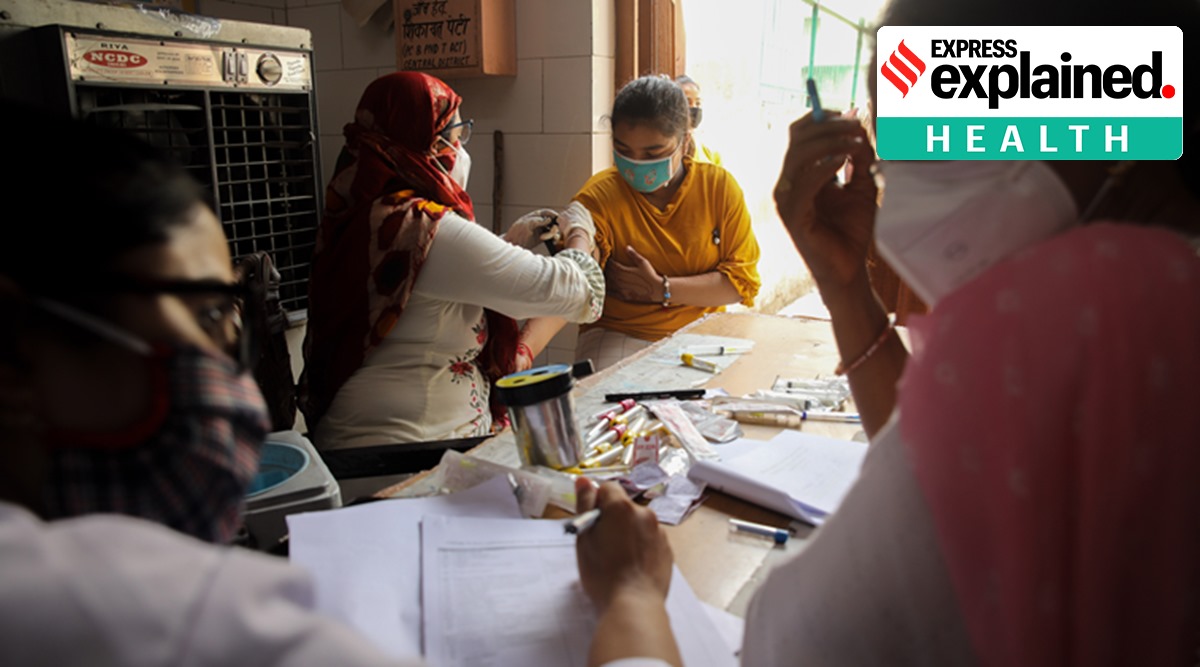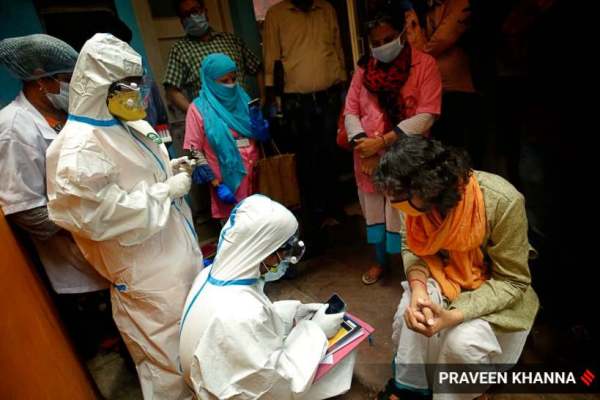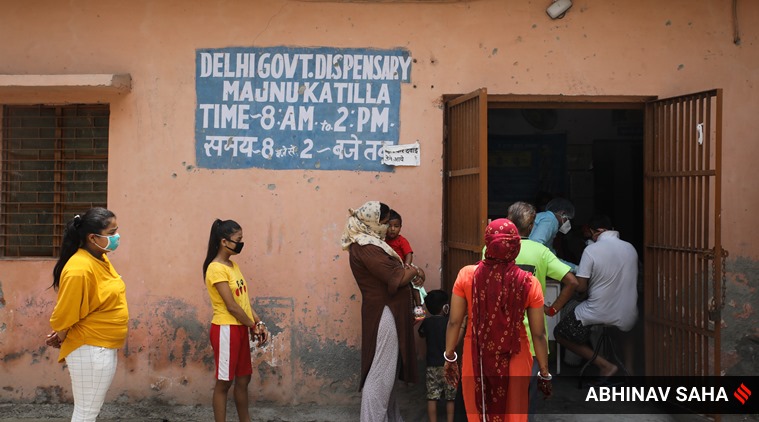
[ad_1]
Pune |
Updated: August 18, 2020 1:30:49 pm
 Health workers collect blood samples during a sero survey in New Delhi on August 4, 2020. (Express Photo: Abhinav Saha)
Health workers collect blood samples during a sero survey in New Delhi on August 4, 2020. (Express Photo: Abhinav Saha)
Written by Vineeta Bal and Satyajit Rath
Since December 2019, the world has been caught up in the pandemic caused by the SARS-CoV-2 virus, leading to the illness called Covid-19. A pandemic of this kind is new reality for us. Newer insights about the infection are still trickling in. As a result, there continues to be a lot of uncertainty about how the pandemic will progress and what needs to be done.
The SARS-CoV2 virus, commonly referred to as ‘the corona virus’, has clearly infected large numbers of people, but it is not clear yet exactly how many people have been infected so far.

We have been using so-called RTPCR tests to detect viral genetic material, or so-called ‘rapid antigen tests’ to detect viral proteins, in nose, throat and mouth fluid to find ‘cases’ of illness. Those are the numbers that are widely reported and discussed so far. But increasingly, new information based on ‘sero-surveys’ has also been emerging.
What are sero-surveys, and what do they tell us?
Sero-surveys use tests that examine the liquid part of blood, or ‘serum’, not nose, throat and mouth fluid. And these tests detect an immune response to the virus material, not SARS-CoV-2 virus material itself.
Upon virus infection, the body comes up with many immune responses. One of these is making proteins called antibodies that stick (or ‘bind’) to the virus – these show up within a few days after infection. The infection itself typically disappears after a couple of weeks. But the anti-virus antibodies, especially the IgG kind, stay around in the blood for a fairly long time, at least for months. These antibodies are made whether the infected person was asymptomatic or had any actual illness. And of course, nobody who has not encountered the virus will have these particular antibodies.
 Sample collection as part of a sero-survey underway in New Delhi. (Express Photo: Praveen Khanna)
Sample collection as part of a sero-survey underway in New Delhi. (Express Photo: Praveen Khanna)
So, if a person was infected, virus material would be detectable in their nose, throat and mouth fluid for a couple of weeks at most. If testing was not done in that time, we would never know if the person had been infected by the virus. But IgG antibodies stay in the blood of such a person for a long time. So, if we test the blood for these antibodies at any point and find them (making the person ‘sero-positive’), we can say that this person had indeed been infected in the recent weeks/months.
Sero-surveys test blood samples of healthy people for anti-SARS-CoV-2 IgG antibodies. Everybody cannot be tested, only a few people chosen at random are tested. The results are an estimate of the proportion of people who have been infected in the past. This information gives a wide-angle picture over time of how the virus has spread in the community.
📣 Express Explained is now on Telegram. Click here to join our channel (@ieexplained) and stay updated with the latest
What do sero-surveys not tell us?
If sero-surveys detect ‘immunity’ to SARS-CoV-2, do they tell us if we are ‘protected’ against the virus? No. All immune responses are not protective. The sero-survey test does not detect ‘protective’ antibodies, just all antibodies (the ‘protective’ ones are much harder to test for on a large scale).
Also, even if it detected ‘protective’ antibodies, we have no idea what levels of ‘protective’ antibodies are necessary for actual protection.
‘Herd immunity’, a recurrent phrase in this context, is a situation in which so many people in the community are immune and protected from the virus that transmission from person to person simply grinds to a halt, even though everybody is not immune and protected.
What proportion of the community should be immune-protected to reach the ‘herd immunity’ point differs from situation to situation. We have no idea what that point is for COVID-19. While sero-surveys are useful in examining herd immunity, they do not tell us whether that point has been reached or not.
 Health workers collect blood samples during a serosurvey in Majnu ka Tila, New Delhi, on August 4, 2020. (Express Photo: Abhinav Saha)
Health workers collect blood samples during a serosurvey in Majnu ka Tila, New Delhi, on August 4, 2020. (Express Photo: Abhinav Saha)
Sero-surveys in India
SARS-CoV-2 sero-surveys are being reported from many areas around the world, with wide variations in the proportions of sero-positive individuals. So far, at least five sero-surveys have been reported from India – an early all-India survey, surveys in Delhi, Mumbai and Berhampur in Odissa, and now from Pune city. Among the earlier city surveys done, Delhi showed ~23% seropositivity, Mumbai showed ~40%, and Berhampur showed ~31%. These numbers are averages, with a lot of variation between neighbourhoods; varying in Mumbai, for example, from 16% to 57%.
The first phase of the Pune city survey tested blood samples from 1,664 randomly chosen adults from five prabhags of Pune Municipal Corporation. These prabhags had high incidence of RT-PCR positive ‘cases’. The test for IgG antibodies recognising receptor-binding-domain of the SARS-CoV2 spike protein is highly specific. The overall sero-positivity is 51.5% of the population, ranging in different areas between 36-65%.
There is more sero-positivity in crowded neighbourhoods such as hutments and tenements. On the other hand, the total number of COVID-19 ‘cases’ reported from these prabhags during the pandemic comes to ~4% of the population.
Don’t miss from Explained | Can a recovered patient be re-infected with Covid-19?
What do the Pune sero-survey numbers tell us, and what do they not tell us?
The Pune sero-survey numbers are unsurprising and consistent with the Delhi, Mumbai and Berhampur numbers. Together, they say that SARS-CoV-2 has been spreading widely in our urban communities, particularly in crowded localities. Clearly, we will have to think again, even officially, about ‘community transmission’.
These numbers also seem to confirm the general impression that most SARS-CoV-2 infections are asymptomatic (some estimates say ~80% are asymptomatic). Most of the volunteers participating in this survey reported no illness over the past few months. Of course, the virus could be spreading from asymptomatically infected people too, especially within families.
But do the Pune numbers tell us exactly how many infections are really asymptomatic? The answer depends on whether we are actually identifying all instances of COVID-19 illness. The likely answer is that we are not.
Despite increased RT-PCR testing capacity, testing volumes are still low. Despite these increases, the proportions of RT-PCR-positive tests are still unchanged, suggesting that we are missing cases. Rapid antigen tests are being used, convenient but possibly less sensitive, and therefore missing cases.
Even more importantly, the misplaced fear of death generated, the real possibility of miserable quarantine and loss of income and support, social stigmatisation and ostracisation, the widespread anecdotes underlining the lack of clarity about hospital resources and costs, all combine to make people reluctant to go for testing.
So long as we keep missing cases, we will not be able to make the best possible use of the sero-surveys to plan effective public health policies for the pandemic.
Future directions based on sero-surveys
Of course, we need more sero-surveys. We need to test more people and more localities, and we need to test the same localities over time, so that we can follow the footprints of the virus moving through our communities. We need to test these blood samples for actual levels of antibodies, and for ‘protective’ antibodies and their levels, so as to begin to understand what actual ‘protection’ would look like.
We need to stop differentiating between ‘us’ and ‘them’. Anybody can get infected; virus is an equaliser and we need to get out of the mentality of ostracising people who need quarantine. And we need these sero-surveys for planning and evaluating vaccine trials as well as eventual vaccine deployment.
(Authors were former scientists at NII, Delhi and specialise in infection and immunity; Vineeta Bal is currently at IISER Pune).
📣 The Indian Express is now on Telegram. Click here to join our channel (@indianexpress) and stay updated with the latest headlines
For all the latest Explained News, download Indian Express App.
© The Indian Express (P) Ltd
[ad_2]
Source link